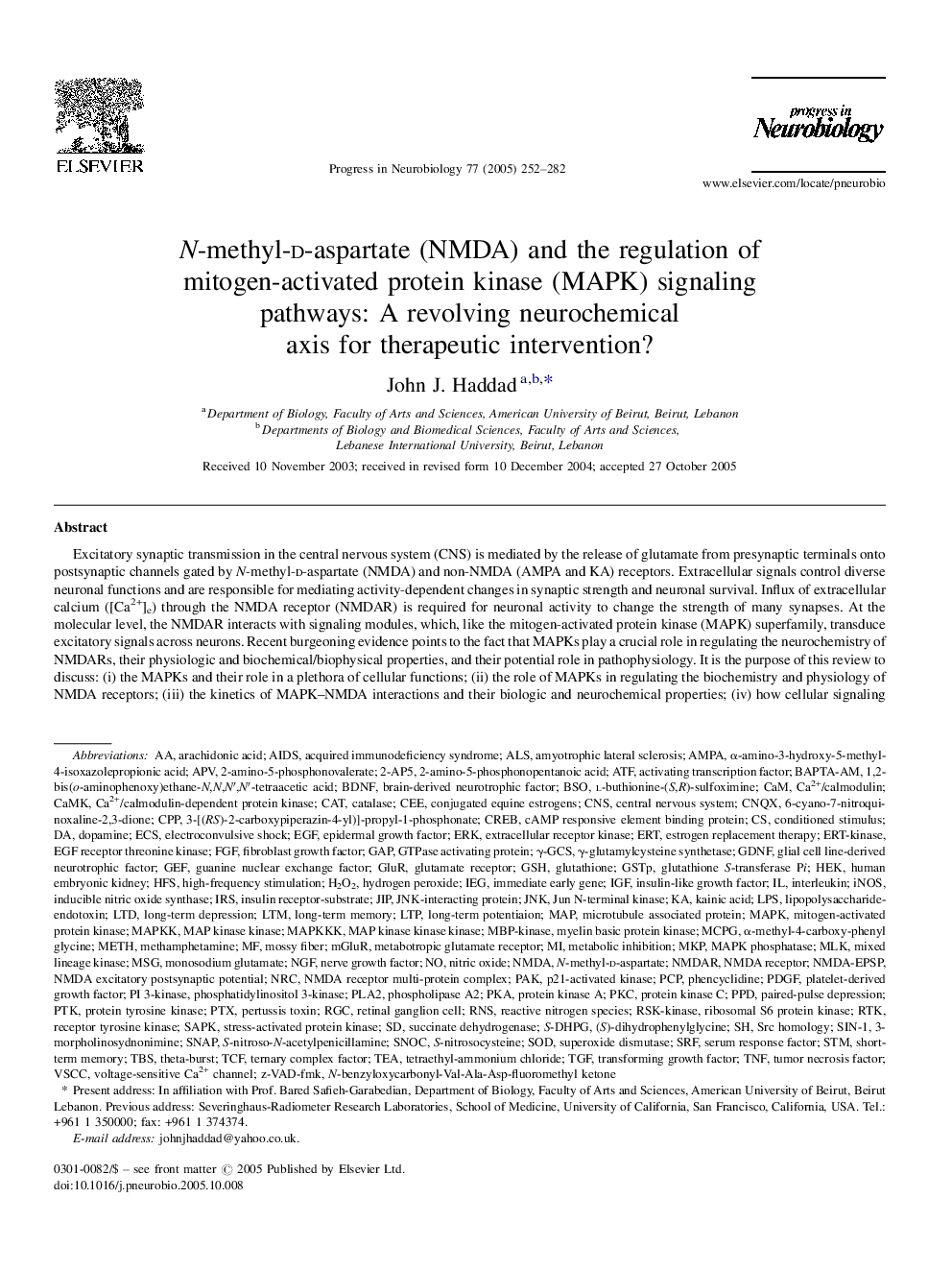| Article ID | Journal | Published Year | Pages | File Type |
|---|---|---|---|---|
| 9435137 | Progress in Neurobiology | 2005 | 31 Pages |
Abstract
Excitatory synaptic transmission in the central nervous system (CNS) is mediated by the release of glutamate from presynaptic terminals onto postsynaptic channels gated by N-methyl-d-aspartate (NMDA) and non-NMDA (AMPA and KA) receptors. Extracellular signals control diverse neuronal functions and are responsible for mediating activity-dependent changes in synaptic strength and neuronal survival. Influx of extracellular calcium ([Ca2+]e) through the NMDA receptor (NMDAR) is required for neuronal activity to change the strength of many synapses. At the molecular level, the NMDAR interacts with signaling modules, which, like the mitogen-activated protein kinase (MAPK) superfamily, transduce excitatory signals across neurons. Recent burgeoning evidence points to the fact that MAPKs play a crucial role in regulating the neurochemistry of NMDARs, their physiologic and biochemical/biophysical properties, and their potential role in pathophysiology. It is the purpose of this review to discuss: (i) the MAPKs and their role in a plethora of cellular functions; (ii) the role of MAPKs in regulating the biochemistry and physiology of NMDA receptors; (iii) the kinetics of MAPK-NMDA interactions and their biologic and neurochemical properties; (iv) how cellular signaling pathways, related cofactors and intracellular conditions affect NMDA-MAPK interactions and (v) the role of NMDA-MAPK pathways in pathophysiology and the evolution of disease conditions. Given the versatility of the NMDA-MAPK interactions, the NMDA-MAPK axis will likely form a neurochemical target for therapeutic interventions.
Keywords
CREBEGFLPSIGFJnkCPPNRCCATGSHHEKATFTBSMSGFGFPCPERKSTMRGCiNOSTCFRNSLTMIRSSRFAMPApKaCaMKNGFNMDAGDNFN-methyl-d-aspartateAPVHFSPKCNMDARGluRPTXmGluRIEGTGFPPDPAKBSOPDGFMAP kinase kinasePLA2GEFMAP kinase kinase kinaseRTKJun N-terminal kinaseGSTPMKPSAPKVSCCSIN-1MCPGγ-GCSSNOCS-nitrosocysteineMAPKKMAPKKKMLKJIPCEEPTKS-nitroso-N-acetylpenicillamineTNFJNK-interacting proteinVoltage-sensitive Ca2+ channelTheta-burstribosomal S6 protein kinase1,2-Bis(o-aminophenoxy)ethane-N,N,N′,N′-tetraacetic acid2-amino-5-phosphonovalerate2-amino-5-phosphonopentanoic acid3-morpholinosydnonimine6-Cyano-7-nitroquinoxaline-2,3-dioneBDNFCa2+/calmodulinECsGTPase Activating Proteinl-buthionine-(S,R)-sulfoximineMAPKMAPK phosphataseNMDA receptorPI 3-kinasez-VAD-fmkγ-glutamylcysteine synthetaseHydrogen peroxidephospholipase A2conjugated equine estrogensamyotrophic lateral sclerosisα-amino-3-hydroxy-5-methyl-4-isoxazolepropionic acidArachidonic acidkainic acidlong-term depressionAIDSinterleukinBAPTA-AMALStransforming growth factorhigh-frequency stimulationLTPlong-term memoryshort-term memoryestrogen replacement therapyCNSDopaminepaired-pulse depressionBiochemistryCAMSODretinal ganglion cellpertussis toxininducible nitric oxide synthaseacquired immunodeficiency syndromeSuperoxide dismutasesuccinate dehydrogenaseCNQXcentral nervous systemSignalingelectroconvulsive shockGAPSNAPepidermal growth factorTernary complex factorplatelet-derived growth factornerve growth factorfibroblast growth factorInsulin-like growth factorGlial cell line-derived neurotrophic factorBrain-derived neurotrophic factortumor necrosis factorserum response factorPhosphatidylinositol 3-kinasePhosphorylationactivating transcription factorPhencyclidinemossy fiberMETHMethamphetamineLTDconditioned stimulusMetabolic inhibitionmapNeurochemistryNitric oxideERTSrc homologyH2O2PathophysiologycAMP responsive element binding proteinProtein tyrosine kinasemicrotubule associated proteinprotein kinase AProtein kinase Cmitogen-activated protein kinaseStress-activated protein kinaseCa2+/calmodulin-dependent protein kinasemyelin basic protein kinaseTEAimmediate early geneCatalaseCalciumhuman embryonic kidneyKinasep21-activated kinasemixed lineage kinaseextracellular receptor kinaseGlutathioneGlutathione S-transferase Piglutamatemonosodium glutamatereactive nitrogen speciesReceptor Tyrosine KinaseMetabotropic glutamate receptorGlutamate receptor
Related Topics
Life Sciences
Neuroscience
Neuroscience (General)
Authors
John J. Haddad,
